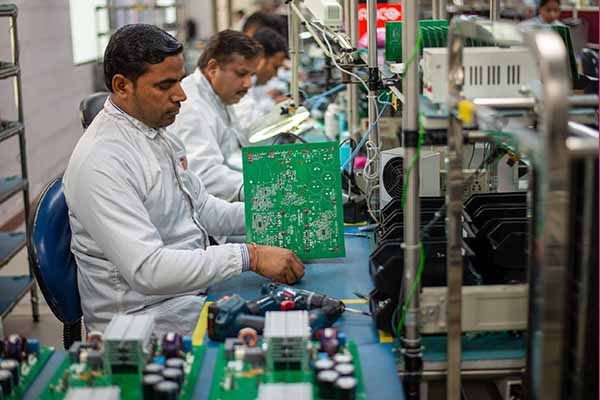The contemporary economy of India is heavily dependent on semiconductors. Semiconductors finds application in a variety of industries, including the military, healthcare, gaming, computer, and communication, as they are smaller, and more dependable.
Since the sectors that use semiconductors as inputs are also experiencing tremendous demand, the Indian semiconductor industry has significant development potential. There is an increasing need for semiconductors from end-use sectors such as mobile devices, telecommunications equipment, information technology, office automation (IT & OA), industrial machinery, autos, and many others require computers. The “Internet of Things” (IoT) concept is now gaining attraction, and the new generation of linked gadgets will significantly boost demand for sophisticated devices.
India’s electronics system design and manufacturing (ESDM) sector are expanding rapidly. With more than 120 units, India also has a substantial design base. The Department of Electronics and Information Technology (DeitY) estimates that India produces nearly 2,000 chips per year. Chip design and verification activities include more than 20,000 engineers. The government is prioritizing development of ESDM ecosystem in India. Several incentives and subsidies are being offered for setting up a electronics manufacturing plants in India.
Why there is a need to manufacture semiconductors in India?
India’s demand for semiconductors has significantly expanded in recent years due to the country’s fast-expanding automotive and electronic device industries. India needs to develop its semiconductor industry to deal with the shortage of semiconductor chips. India produces smartphones for brands like Apple, Xiaomi, Realme, Oppo, Samsung, and others. Amitabh Kant, the CEO of the Indian think tank NITI Aayog, claims that India is currently the world’s second-largest producer of mobile phones. There are currently more than 200 factories in the country making mobile phones. From 60 million mobile phones in 2014–150 to roughly 300 million mobile phones in 2020–21, production grew. India is thus not too distant from the production of semiconductors.
India’s economy greatly benefits from the industrial sector. Many companies in this area rely significantly on semiconductor chips, which are fundamental to many consumer items. India must lessen its reliance on international supply and develop semiconductor chips. With the introduction of production-linked programs and other incentives for semiconductor makers, the Indian government has taken the right steps in that direction. The semiconductor market in India is expected to increase from USD15 billion in 2020 to USD63
billion by 2026. According to the KOTRA Mumbai Trade Center and the India Electronics and Semiconductor Association, semiconductor consumption in India is anticipated to increase from USD21 billion in 2019 to USD400 billion by 2025. (IESA).
The lack of semiconductors would also affect India’s military industry. India seeks to expand domestic production and decrease defense equipment imports. Semiconductors play a crucial role in missile guidance systems, aviation and naval navigation, and other defense systems. Therefore, India needs to manufacture semiconductor to overcome the shortage.
What is the current scenario of the semiconductors market in India?
The current semiconductor market is further segmented into the following sectors: mobile & wearables, information technology, industrial, consumer electronics, telecommunications, automotive, and aerospace & defence. All chips are now imported into India, and the market is expected to increase from USD24 billion to USD100 billion by 2025. However, for domestic semiconductor chip production, by 2026 and 2030, India’s domestic semiconductor usage is anticipated to surpass USD 80 billion.

The highest semiconductor market share in India is held by mobile and wearable technology (52%), followed by IT. The percentage of automotive technology is expected to increase from 25% to 30% in the upcoming years.
Does India have the capacity to manufacture semiconductors indigenously in terms of resources like raw materials, skills etc.?
The major minerals which are used to build semiconductors are silicon, germanium, metals, gallium arsenide. Apart from Silicon and metals, germanium and gallium arsenide are rarely found in India. Germanium is to be found in the Gondwana coals of Jharkhand, and gallium arsenide is to be found at the National Aluminium Refinery, Damanjodi, Orissa.
The answer is yes, it is possible to manufacture semiconductors indigenously but has challenges to proceeding further. But with the help of government initiatives, India could be the world’s foremost manufacturer of semiconductors in the next decade.
In the forthcoming decades, it is also unlikely that supplies of several essential components will rise much without a significant technological advance.
Manufacturing semiconductors and displays is a highly complicated and technologically advanced industry that requires considerable and persistent expenditures because of its high capital costs, high risk, lengthy gestation and payback times, and fast technological development.
How can India’s dependence on other countries for semiconductors affect its national and economic security?
Currently, India is fully dependent on other country for import of semiconductors. The major import countries are China, Singapore, Hong Kong, Japan, Germany, South Korea, Thailand, and other countries (USA, Malaysia, Vietnam, France, etc.).
India’s market is largely dominated by Asian nations. In terms of semiconductor imports, China leads the list. It has the share of 68.10% followed by Singapore which has a market of 9.88%.

Source: Observatory of Economic Complexity (OEC)
China is continuously target India in terms of politically as well as economically. India depends on it since majority of smartphones and phones are made in China.
There might be possibility of surveillance and spying by the Chinese Government on India. Supply chain concerns arise from the concentration of fabrication facilities in China; trade dispute, armed conflict, or other disruption in the area might have a large impact on India’s access to semiconductors. Through subsidies, tax breaks, coercion into joint ventures, compelled technology transfers, and discriminatory antitrust and security tactics, the Chinese Communist Party distorts the market.
How can India balance semiconductors imports and indigenous manufacturing? Since leading manufacturers are far ahead of India in terms of technological advancement?
India needs to balance its imports of semiconductors and put more emphasis on homegrown production. It also needs to be much more ambitious in developing a domestic semiconductor industry, complete with all backward links, and not just provide financial incentives for businesses to relocate there. The feedback on the government’s USD10 billion incentive programs for building sophisticated microelectronics, including the display and semiconductor fabs, supports the thesis. The government should help domestic manufacturers that build semiconductor fabs and manufacturing plants increase production by providing them with funds and tax redemptions.
Export and import of semiconductor in India
(HS Code 8541-Semiconductor Devices (Diodes, transistors and semi-conductor based inducers), Photosensitive semi-conductor devices, including photovoltaic cells whether or not assembled in modules or made-up into panels; Light emitting diodes; Mounted piezo-electric crystal).
| Years | Export Sum of Trade Value (USD Billion) | Import Sum of Trade Value (USD Billion) | Total Sum of Trade Value (USD Billion) |
| 2018 | 0.15 | 3.54 | 3.68 |
| 2019 | 0.35 | 3.20 | 3.56 |
| 2020 | 0.16 | 2.17 | 2.33 |
| 2021 | 0.22 | 5.02 | 5.24 |
| Total | 0.89 | 13.93 | 14.83 |
Some government initiatives have been taken to tackle the shortage situation in semiconductors:
- First Semicon India Conference 2022 was launched by Prime Minister Narendra Modi in Bengaluru with the goal of launching India’s desire to become the world’s semiconductor hub and fostering the chip design and manufacturing ecosystem. Theme of the conference was “Catalyzing India’s Semiconductor Ecosystem”.
- The first state to implement a semiconductor policy is Gujarat. The Gujarati government released a specific “Gujarat Semiconductor Policy 2022–27”. This new program provides several incentives and subsidies to support the production of semiconductors.
The design-linked incentive (DLI) plan was created to assist young Indian semiconductor design companies. A significant, skilled technical workforce, favourable government regulations, and foreign direct investment have made India an important global hub for chip design. But foreign businesses own most of the designed intellectual property (IP).
In the second design, semiconductor fabs are addressed. To establish India as a hub for Electronics System Design and Manufacturing (ESDM) on a global scale and to foster a competitive environment for the sector, the National Policy on Electronics 2019 (NPE 2019) has two main objectives. Facilitating the establishment of semiconductor wafer manufacturing facilities and its ecosystem for the design and manufacture of chip components is one of the primary initiatives of NPE 2019.
The Scheme for Establishing Semiconductor Fabs in India would provide the accepted applicants with fiscal support equal to up to 50% of the project cost on a pari-passu basis. The Expenditure Finance Committee, which is presided over by the Secretary of the Department of Expenditure, will evaluate the plan.
About the author:

Karan Chechi is a seasoned market research and consulting professional specializing in creative and innovative strategies and methods of new market penetration, new product development, and product introductions with over a decade of experience. This experience coupled with research and interfacing with customers, gives him the ability to spot new market and product opportunities for his clients.















